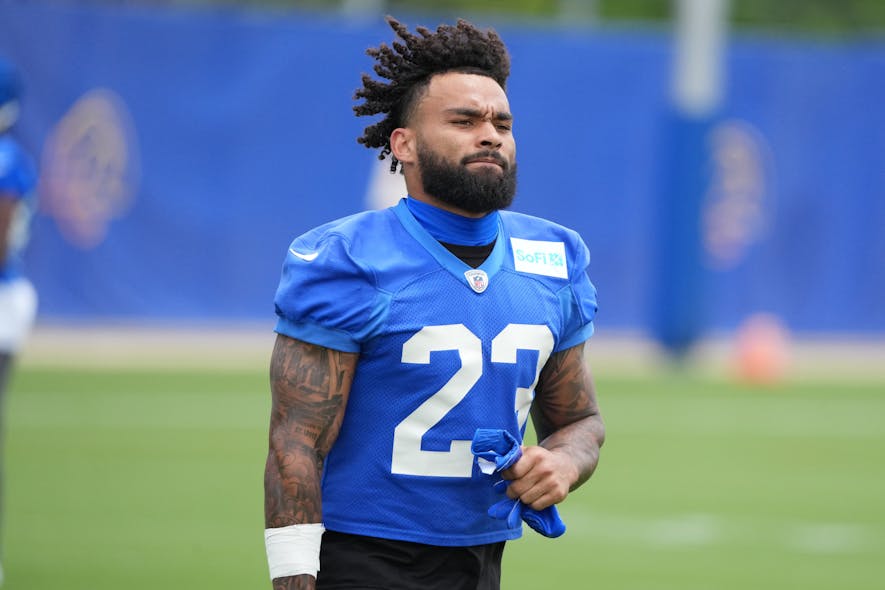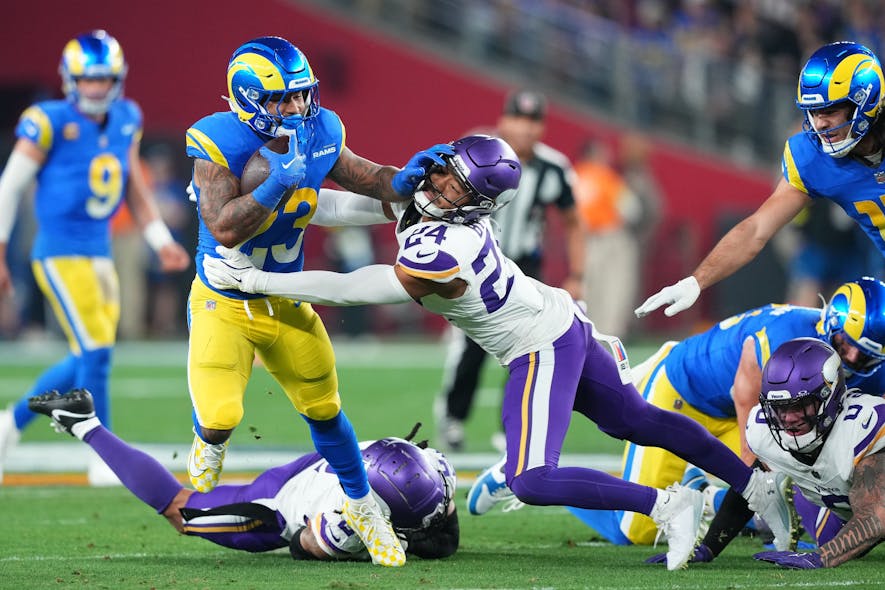RELATED: See all of our 2025 Player Spotlights here.
Kyren Williams has posted back-to-back RB7 seasons in point-per-reception (PPR) scoring systems, but the high volume that fueled those fantasy finishes raises caution flags for his 2025 outlook.
A former 5th-round pick out of Notre Dame, Williams emerged from the Rams' 2022 training camp behind Cam Akers and Darrell Henderson Jr. as the team's RB3. He played in 10 games but was lightly used, touching the ball just 44 times. He opened the 2023 season as the RB2 on the depth chart behind Akers, but seized the starting job in Week 2, and Akers was traded to Minnesota. Williams started the next five games before missing the next four because of a high ankle sprain, then played the next six. Despite playing in just 12 games, Williams ranked third in the league in rushing yards (1,144) and tied for the fifth-most rushing touchdowns (12).
When the Rams spent a 2024 third-round pick to take Blake Corum, many expected to see Williams's workload reduced from the 21.7 touches per game he averaged in 2023. It didn't happen. Despite playing in every game, Corum carried the ball just 58 times for 207 yards and added seven receptions for 58 yards. Instead, head coach and offensive play-caller Sean McVay leaned even more heavily into Williams, making him arguably the most-used running back in the league.
Players With at Least 70% of Their Team's RB Touches in 2024
| player | team | Touches | % RB Touches | Rushes | % Team Rushes |
|---|---|---|---|---|---|
| Kyren Williams | LAR | 350 | 78.80% | 316 | 72.80% |
| D'Andre Swift | CHI | 295 | 75.40% | 253 | 60.80% |
| Saquon Barkley | PHI | 380 | 74.80% | 347 | 58.30% |
| Derrick Henry | BAL | 342 | 74.30% | 323 | 60.50% |
| Jonathan Taylor | IND | 323 | 73.70% | 305 | 62.90% |
| Chuba Hubbard | CAR | 294 | 70.80% | 251 | 62.60% |
Williams accounted for nearly 80 percent of all touches by Rams running backs, and he was the only player in the league to handle at least 70 percent of his team's total rushing attempts, including those by players other than running backs. His 350 touches were the third-most in the regular season among running backs behind Saquon Barkley (380) and Bijan Robinson (364).
McVay's History of Workhorse Backs
McVay has shown a decade-long tendency to ride his workhorse when he has a healthy one. The running back position is fraught with injuries, so the strategy sometimes forces what appears in the final stat sheet to be a committee approach. However, even when his workhorse back misses significant time, he retains the habit of riding whatever horse he has in the stable. When they're healthy, his RB1s can deliver workhorse seasons – a high volume coupled with a high share of touches – that provide potentially league-winning fantasy points.
Six workhorse seasons have been produced in McVay's system by three running backs: Doug Martin, Todd Gurley, and Kyren Williams.
Regular-Season Stats for McVay's Workhorses
| Season | Running Back | Snaps | Touches | Rushes | Rush Yards | Yards/Rush |
|---|---|---|---|---|---|---|
| 2015 | Doug Martin | 622 | 321 | 288 | 1402 | 4.87 |
| 2017 | Todd Gurley | 788 | 343 | 279 | 1305 | 4.68 |
| 2018 | Todd Gurley | 825 | 319 | 260 | 1255 | 4.83 |
| 2019 | Todd Gurley | 787 | 255 | 224 | 859 | 3.83 |
| 2023 | Kyren Williams | 678 | 261 | 229 | 1146 | 5.00 |
| 2024 | Kyren Williams | 888 | 350 | 316 | 1299 | 4.11 |
While he was the offensive coordinator in Tampa Bay, McVay leaned heavily on Martin when he was healthy. Martin accounted for nearly two-thirds of all running back touches during the 2015 season, during which he played every game. Sandwiched around that campaign were seasons in which he missed five games in one and a half of the other. In his absence, McVay platooned his backs in more of a committee-type pattern.
Gurley was already being utilized heavily by the Rams prior to McVay's arrival, and he continued to operate as a workhorse under his new head coach. His nearly 4,000 yards from scrimmage in 2017 and 2018 combined were nearly 700 more yards than the closest running back, and he posted back-to-back top-three fantasy seasons. However, his efficiency and workload declined considerably in 2019, and he was released the following March.
Per-Game Averages for McVay's Workhorses
| Season | Running Back | Snaps | Touches | Rushes | Rush Yards | PPR Pts |
|---|---|---|---|---|---|---|
| 2015 | Doug Martin | 38.9 | 20.1 | 18.0 | 87.6 | 15.1 |
| 2017 | Todd Gurley | 52.5 | 22.9 | 18.6 | 87.0 | 25.8 |
| 2018 | Todd Gurley | 58.9 | 22.8 | 18.6 | 89.6 | 26.3 |
| 2019 | Todd Gurley | 52.5 | 17.0 | 14.9 | 57.3 | 14.8 |
| 2023 | Kyren Williams | 56.5 | 21.8 | 19.1 | 95.5 | 21.4 |
| 2024 | Kyren Williams | 55.5 | 21.9 | 19.8 | 81.2 | 17.4 |
After Gurley, McVay attempted to use other backs as a workhorse. He twice put Cam Akers in that role. He was fully healthy for six of the final seven weeks of the 2020 season. In those games, he had 132 out of 154 (86 percent) of the running backs' rush attempts. Two years later, he had 104 out of 124 rush attempts (84 percent) over the final six regular-season games. Injuries cost him games in both of those seasons and all of the 2021 season.
With Akers on the shelf, McVay turned to Darrell Henderson Jr. as a workhorse. He handled 71 percent of the Rams' rushing attempts in the seven games he played out of the first eight weeks of the 2021 season but struggled thereafter before missing the final five games with a sprained knee. For those five weeks, Sony Michel acted as the workhorse. Akers and Henderson traded starts over the 2022 season before Williams claimed the workhorse role.
Williams's Workhorse Window Remains Open
Williams has been McVay's busiest back since Gurley's 2018 season. Injuries kept Williams out of four games during the middle of the 2023 season, but he otherwise delivered league-winning fantasy performances that season. His 19.1 rushing attempts per game were the most by any regularly starting running back playing for McVay. Williams has handled an average of 83 percent of all touches by Rams running backs over the past two seasons, excluding games in which he did not play. This is reminiscent of Gurley's prime, and his snap share is the highest of any back under McVay.
Share of RB Workload in Games Played by McVay's 'Workhorses'
| Season | Running Back | Games | Snaps | Touches | Rushes | Rush Yards |
|---|---|---|---|---|---|---|
| 2015 | Doug Martin | 16 | 56% | 66% | 72% | 72% |
| 2017 | Todd Gurley | 16 | 86% | 85% | 84% | 86% |
| 2018 | Todd Gurley | 17 | 81% | 78% | 75% | 77% |
| 2019 | Todd Gurley | 15 | 75% | 72% | 70% | 72% |
| 2023 | Kyren Williams | 13 | 85% | 82% | 82% | 86% |
| 2024 | Kyren Williams | 18 | 88% | 84% | 84% | 85% |
Kyren Williams is once again poised to take on the workhorse role with Corum behind him on the depth chart. The Rams' biggest addition to the running-back room is Jarquez Hunter, whom they selected in the fourth round of this year's NFL Draft. Hunter enters the NFL after rushing for 1,201 yards and eight touchdowns at Auburn, where he averaged 6.3 yards per carry over his four-season collegiate career. He has a complementary skill set to Williams but is faster and more explosive. Williams is a superior receiving threat and pass blocker. As our Craig Lakins noted, "There's no reason to believe Hunter will threaten for the starting role this season, barring a Williams injury." However, he may threaten Corum for playing time as the team's RB2.
The remaining backs on the depth chart are three former undrafted free agents: Ronnie Rivers, Cody Schrader, and rookie Jordan Waters. Rivers, entering his fourth season in Los Angeles, has 63 career carries. Schrader had one carry in 2024, his rookie season. Waters, who played at North Carolina State, was picked up earlier this year. None of them is expected to play a significant role in the offense, barring multiple concurrent injuries.
Williams will be the third workhorse back to play a third season for McVay. The last two such third seasons saw dramatic drops in production. Doug Martin maintained nearly the same number of touches per game, but the games dropped by half. His efficiency also took a hit, falling to a career-low 2.9 yards per carry from 4.9 the previous season. His total touchdowns also dropped by more than half to three from seven. After being the RB4 in PPR systems in 2015, Martin tumbled to RB55.
Gurley was likely to regress statistically following back-to-back scintillating seasons, during which he was the overall RB1 with 387 PPR points (25.8 per game) in 2017 and the RB3 with 368 PPR points (26.3 per game) in 2018. He played an additional game in 2019, but he had 33 fewer rushing attempts and 28 fewer receptions. Hampered by an arthritic knee, Gurley gained nearly one fewer yard per rush and three yards per reception. His total touchdowns dropped to 14 from 21, and he averaged 11.6 fewer fantasy points per game. Nonetheless, he ended the season with a respectable RB14 finish unless you were the fantasy manager who spent a first-round pick on him or paid a premium price for him in a trade.
These declines in third-year seasons for McVay's workhorses are not the only cautionary tale for fantasy managers looking at drafting Williams at his current low-RB1 average draft position (ADP). Running backs generally suffer the most wear and tear of fantasy-relevant players, and their careers are typically shorter and include a sudden decline in volume, efficiency, or both. If we accept that backs with more touches generally accumulate more wear and tear than those with fewer touches, then high-volume backs become riskier to draft at ADP as that volume increases.
Workhorses Succumbing to a 'Scourge of 600'?
My colleague Gary Davenport has written about the "Curse of 370," the tendency of running backs' performance to decline sharply the year after they touched the ball 370 or more times in a regular season. Williams fell 20 touches short of that threshold last season, but 370 is not some magic cutoff below which a running back is immune. "There is data to support that even at 325 touches, a running back is more likely to regress the following season than to meet or surpass the prior campaign," Gary noted. "The workload from the previous season absolutely matters."
What about the cumulative effect of two seasons of high-volume workloads?



